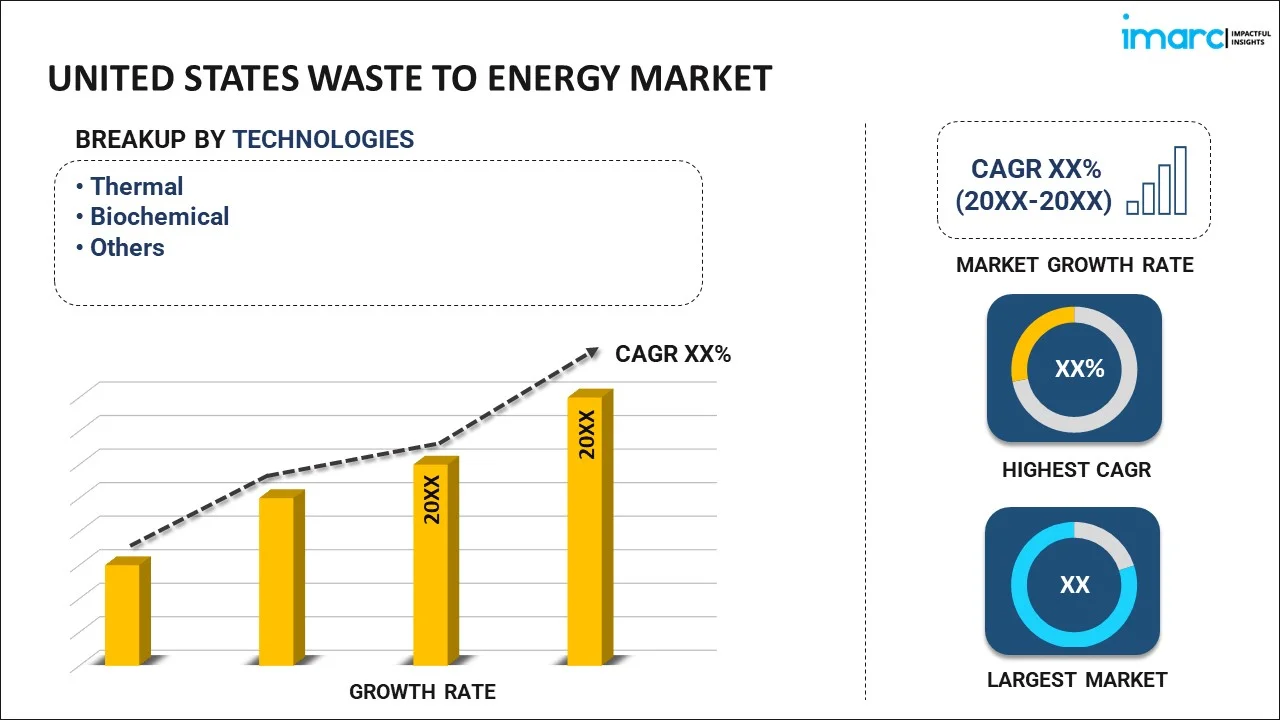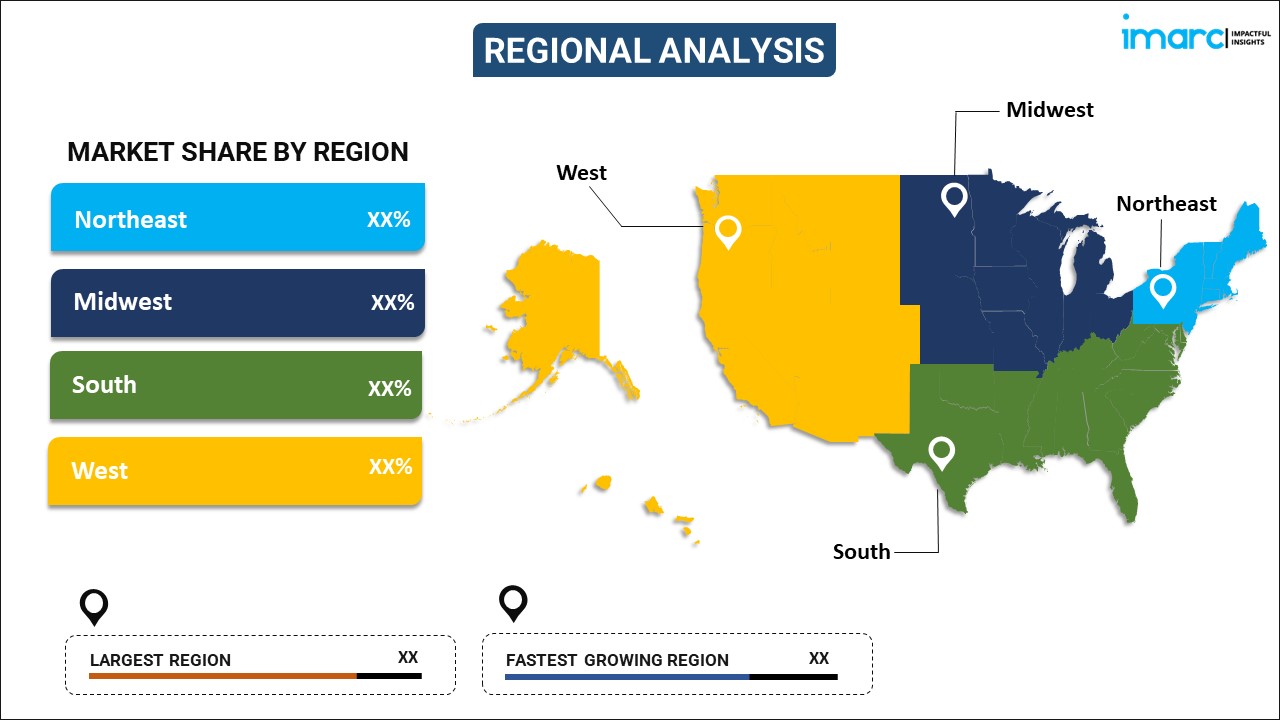
United States Waste to Energy Market Report by Technology (Thermal, Biochemical, and Others), Waste Type (Municipal Waste, Process Waste, Agriculture Waste, Medical Waste, and Others), and Region 2024-2032
Market Overview:
United States waste to energy market size is projected to exhibit a growth rate (CAGR) of 7.46% during 2024-2032. The escalating environmental awareness, surging municipal solid waste volumes, stringent regulations promoting sustainable waste management, a shift towards renewable energy sources, rapid technological advancements, increasing energy security concerns, and growing public acceptance are some of the major factors influencing the market growth.
|
Report Attribute
|
Key Statistics
|
|---|---|
|
Base Year
|
2023 |
|
Forecast Years
|
2024-2032
|
|
Historical Years
|
2018-2023
|
| Market Growth Rate (2024-2032) | 7.46% |
Waste-to-energy (WtE) is a sustainable process that converts various types of waste materials into electricity, heat, or other valuable forms of energy. This environmentally responsible approach addresses two critical challenges simultaneously: waste management and energy production. The process typically involves the combustion of waste materials at high temperatures, which releases energy in the form of heat. This heat is then used to generate electricity through steam turbines or to provide district heating. The primary types of waste materials utilized in WtE include municipal solid waste (MSW), biomass, and industrial waste. Waste-to-energy facilities employ advanced technologies to ensure efficient and environmentally friendly operations. The process starts with the collection and sorting of waste materials, removing recyclables and hazardous substances to prevent pollution. The remaining waste is then combusted in specialized incineration or gasification chambers, where the generated heat is captured and converted into electricity or heat energy. The advantages of waste-to-energy are manifold, such as it helps in the effective disposal of non-recyclable and non-compostable waste materials, minimizing their environmental impact. Additionally, it contributes to the diversification of the energy mix, promoting cleaner energy production and reducing reliance on fossil fuels. Furthermore, WtE facilities generate revenue from electricity sales and, in some cases, through the sale of recovered metals from the incineration process.
United States Waste to Energy Market Trends:
The United States waste to energy market is influenced by several key drivers, such as the increasing concerns regarding environmental sustainability and the need for more eco-friendly waste disposal methods. Additionally, the rising volume of municipal solid waste generated across the country has created a pressing need for efficient waste management solutions, further propelling the market growth. In line with this, government initiatives and regulations aimed at reducing landfill usage and lowering greenhouse gas emissions have also played a pivotal role in driving the adoption of waste-to-energy technologies, which is boosting the market growth. Furthermore, the pursuit of energy diversification and the need to reduce dependence on fossil fuels has led to a growing emphasis on renewable energy sources, which is fueling the market growth. Moreover, the availability of federal and state incentives and subsidies for waste-to-energy projects has provided financial incentives for both public and private sector investments in the sector, which is accelerating the market growth.
United States Waste to Energy Market Segmentation:
IMARC Group provides an analysis of the key trends in each segment of the market, along with forecasts at the country level for 2024-2032. Our report has categorized the market based on technology and waste type.
Technology Insights:

- Thermal
- Incineration
- Pyrolysis
- Gasification
- Biochemical
- Others
The report has provided a detailed breakup and analysis of the market based on the technology. This includes thermal (incineration, pyrolysis, and gasification), biochemical, and others.
Waste Type Insights:
- Municipal Waste
- Process Waste
- Agriculture Waste
- Medical Waste
- Others
A detailed breakup and analysis of the market based on the waste type have also been provided in the report. This includes the municipal waste, process waste, agriculture waste, medical waste, and others.
Regional Insights:

- Northeast
- Midwest
- South
- West
The report has also provided a comprehensive analysis of all the major regional markets, which include the Northeast, Midwest, South, and West.
Competitive Landscape:
The market research report has also provided a comprehensive analysis of the competitive landscape in the market. Competitive analysis such as market structure, key player positioning, top winning strategies, competitive dashboard, and company evaluation quadrant has been covered in the report. Also, detailed profiles of all major companies have been provided.
United States Waste to Energy Market Report Coverage:
| Report Features | Details |
|---|---|
| Base Year of the Analysis | 2023 |
| Historical Period | 2018-2023 |
| Forecast Period | 2024-2032 |
| Units | US$ Million |
| Scope of the Report | Exploration of Historical and Forecast Trends, Industry Catalysts and Challenges, Segment-Wise Historical and Predictive Market Assessment:
|
| Technologies Covered |
|
| Waste Types Covered | Municipal Waste, Process Waste, Agriculture Waste, Medical Waste, Others |
| Regions Covered | Northeast, Midwest, South, West |
| Customization Scope | 10% Free Customization |
| Report Price and Purchase Option | Single User License: US$ 3699 Five User License: US$ 4699 Corporate License: US$ 5699 |
| Post-Sale Analyst Support | 10-12 Weeks |
| Delivery Format | PDF and Excel through Email (We can also provide the editable version of the report in PPT/Word format on special request) |
Key Questions Answered in This Report:
- How has the United States waste to energy market performed so far and how will it perform in the coming years?
- What has been the impact of COVID-19 on the United States waste to energy market?
- What is the breakup of the United States waste to energy market on the basis of technology?
- What is the breakup of the United States waste to energy market on the basis of waste type?
- What are the various stages in the value chain of the United States waste to energy market?
- What are the key driving factors and challenges in the United States waste to energy?
- What is the structure of the United States waste to energy market and who are the key players?
- What is the degree of competition in the United States waste to energy market?
Key Benefits for Stakeholders:
- IMARC’s industry report offers a comprehensive quantitative analysis of various market segments, historical and current market trends, market forecasts, and dynamics of the United States waste to energy market from 2018-2032.
- The research report provides the latest information on the market drivers, challenges, and opportunities in the United States waste to energy market.
- Porter's five forces analysis assist stakeholders in assessing the impact of new entrants, competitive rivalry, supplier power, buyer power, and the threat of substitution. It helps stakeholders to analyze the level of competition within the United States waste to energy industry and its attractiveness.
- Competitive landscape allows stakeholders to understand their competitive environment and provides an insight into the current positions of key players in the market.
Need more help?
- Speak to our experienced analysts for insights on the current market scenarios.
- Include additional segments and countries to customize the report as per your requirement.
- Gain an unparalleled competitive advantage in your domain by understanding how to utilize the report and positively impacting your operations and revenue.
- For further assistance, please connect with our analysts.
 Inquire Before Buying
Inquire Before Buying
 Speak to an Analyst
Speak to an Analyst
 Request Brochure
Request Brochure
 Request Customization
Request Customization




.webp)




.webp)












